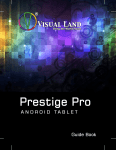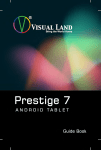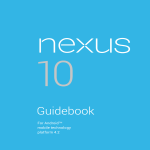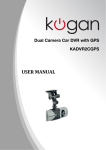Download KAPHNHDQCXA Agora HD Smartphone User Manual
Transcript
GETTING STARTED INSERT SIM CARD The phone is a dual SIM mobile phone, allowing you to use the handset for two networks and/or mobile phone accounts. To insert the SIM card(s): 1 – Switch off the mobile phone and remove the rear cover and battery. 2 – Insert the SIM card correctly in the card slot(s). (See figure below) 3 – Finally insert the battery and replace the rear cover of the mobile phone. INSERT MEMORY CARD 1 – Power off the mobile phone and remove the rear cover and battery. 2 – Insert the microSD card into the slot. (See figure below) 3 – Finally insert the battery and replace the rear cover of the mobile phone. NOTE: After inserting the microSD card into the slot, you must reboot the mobile phone; otherwise the mobile phone will not identify the microSD card. Use only compatible memory cards for use with this device. Incompatible memory cards may damage the card or the device and corrupt the data stored in the card. Charge the Battery / Connect to a Computer You can charge the battery of the phone by connecting the USB cable (supplied with this phone) to the computer, or via a generic USB wall charger (not included). Note: Please use the specific supplied battery, otherwise it may cause an explosion; while your mobile phone is running normally, it is suggested that you do not pull the battery out of the phone at random times, as it may cause accidents and issues, i.e. loss of important data, corrupt firmware etc. KEYS AND PARTS The Agora smartphone offers you amazing functionality, such as the 8 megapixel camera, video recorder, FM radio, music and sound recording. You are able to install various APPs, games and more (supports APK format) by downloading them from Android markets. Locking and Unlocking the Screen Press the power button to enter sleep mode, at which point the screen will be locked. Press the power button again to wake the phone up, then drag to lock icon to the righthand side with your finger to unlock the handset. MAKE IT YOURS – CUSTOMIZING THE HANDSET 1 – Home Screen: It is your starting point to access all the features on your phone. It displays icons, widgets, shortcuts and other features. 2 – Notification Bar: At the top of the screen, the status bar displays the time, status and notifications. If there is a new message, missed call or something in the notification bar, you can drag it down to open the panel, then you can click the desired notification to view. When you have finished, you can close it again by dragging the panel up or by pressing “Back”. 3 – Launcher: Touch the Launcher icon at the bottom of the screen to view all installed applications. (1) (2) (3) Adding Widgets and more icons to the Home Screen Enter the launcher and hold your finger down on an application until the screen vibrates, then release your finger. Rearranging (1) or removing (2) widgets and icons from the Home Screen 1 – Hold down your finger on the icon that you want to move. Once the phone vibrates, don't release your finger, but instead drag the widget or icon to a new location on the screen. 2 – Hold down your finger on the icon of the widget that you want to remove. Once the phone vibrates, drag the widget up to the “X Remove” text, which will turn red. Release the icon over this text and the widget will disappear from your Home Screen. (See figure below) THE LAUNCHER Opening and Switching Applications The launcher holds icons for all of the applications on your phone, including any applications that you have downloaded from the Android Market or other sources. On the Home Screen, touch the Launcher Icon to open the main menu. Press the Home Icon or the Back Button to close the Launcher again. Switch to Recently Used Applications Press and hold the home icon (center icon on the bottom front of the screen) for a few seconds. You will then see the screen below, showing the recently used applications still running in the background. Making a Call On the start screen, select the small green phone icon, then enter a complete phone number to make a call. If using Dual SIM cards, you can select which SIM is to be used to make the phone call at the bottom of the screen. Call Log In the call log options, you can make a call, add a new contact or send messages etc.. Rejecting a Call by Sending a Busy Message While there is an incoming call, there will be times when it is inconvenient or undesirable to accept the call. In these cases you can send a busy message for rejecting the call. To do so, simply drag the circle up to , at which point you will get a list of messages that can be sent out. Tap your desired busy message. Adding Contacts Tap and enter Contacts, then add a contact (see figures below.) Tap to add a new contact to the Phone or SIM card. Sending and Receiving Messages Enter messaging, and then compose a new message. You touch the text field where you want to enter the text, which will open the keyboard. 1 – When composing a new text message, you can select text for cutting or copying. The selected text will be highlighted in blue. Touch the text field or portion that contains the text (as shown in the figure below). You can then select all contexts of copy, cut and paste. 2 – When a new message arrives, you can read it by dragging the notification panel down and clicking on the message, or by entering the Messaging section to read it directly. Further Messaging Options 1 – Long press on a message thread, then you can delete the entire conversation. 2 – Touch and hold a message in the message thread view, at which point you will receive a menu with message options. You can then follow these options, which include forwarding the messages to other numbers. Browsing the Web To browse the internet, you will need to switch on Data connection or turn on Wi-Fi if it is available. To do this, press the Menu button on the handset while on the Home Screen, then select “System Settings”. You will then see the option to toggle Wi-Fi ON or OFF. Once you have a viable data connection, you may open the web browser and surf the internet successfully. Downloading Applications from the Android Market 1 – Add your Google Account. You can do this from the “Add Account” link in the System Settings. 2 – Enter the Android Market (Google Play Store) and download apps. Managing/Uninstalling Applications Enter Settings > Apps, then manage the applications. As you install downloaded apps, you will need to turn on “Unknown Sources” in your security settings. Maintenance and Safety Please read and observe the following information for the safe and proper use of you phone to prevent damage. Also, keep the users guide in an accessible place at all times after reading it. 1 – After Sales Service Contact the Kogan customer support team for all enquiries. 2 – Charger and Adaptor Safety Charger and adapter are designed for indoor use only. 3 – Battery Information and Care • Please use the specific battery supplied, otherwise it may cause catastrophic failure. • Please dispose of the battery properly. • Do not disassemble or short-circuit the battery. • Keep the battery's metal contacts clean. • Recharge the battery after long periods of non-use to maximize the battery life. • Battery life may vary due to usage patterns and environmental conditions. • The self-protection function of the battery cuts the power of the phone when it's operation is in an abnormal status. In this case, remove the battery from the phone, wait 10 seconds, reinsert the battery and then turn the phone on. 4 – General Notice • Using a damaged battery or placing the battery in your mouth may cause serious injury. • Do not place items containing magnetic components such as a credit card, phone card, bank book or electronic public transport ticket near the phone. The magnetism of the phone may damage the data stored in the magnetic strip. • Talking on your phone for long periods of time may reduce call quality due to heat generated during use. • When the phone is not being used for a long time, store it in a safe place with the power cord unplugged. • Using the phone in proximity to receiving equipment (ie a TV or radio) may cause interference on the phone. • Do not immerse your phone in water. If this happens, remove the battery and contact the Kogan customer support team for further instructions, however repairs will not be covered by warranty. • Do not paint your phone. • The data saved in your phone may be deleted due to careless use, repair of the phone or by upgrading the software. Please backup your important phone contacts and files. Ring tones, text messages, voice messages, pictures and videos may all also be deleted. Kogan is not liable for damages caused by loss of data. • Do not turn your phone on or off when it is close to your ear. • Do not throw the phone at a person or animal. Kogan will NOT bear responsibility for any non-compliance with the above guidelines or improper use of the mobile phone. Our company keeps the right to make modifications to any of the content contained in this user guide without public announcement in advance. The contents of this manual may vary from the actual content contained in the device, in which case the content on the phone shall govern. What's new in Android? • Gesture Typing (Android 4.2) Instead of typing each letter, use Gesture Typing to input a word without lifting your finger. You don't need to worry about adding spaces because they're added automatically for you. Glide your fingers over the letters you want to type, and lift it after each word. • Photo Sphere Mode (Android 4.2) Use Photo Sphere mode in the Camera app to capture 360-degree photos. Touch the Camera icon to open the app, then touch the mode options to select the Photo Sphere mode. • Google Play Widgets New widgets on your Home screens display recently used apps, music, movies, books or games that you already have – including preloaded content that comes with the device. Other widgets offer suggestions for browsing Google Play. Touch a widget to access its content on Google Play. Touch & hold a widget to resize it or remove it. • Quick Settings (Android 4.2) Use Quick Settings to easily access Wi-Fi settings, manage display brightness, open the main Settings menu and more. Swipe down with two fingers from the top of the screen to open Quick Settings, then touch one of the boxes to open a specific setting. • Expandable Notifications Expandable notifications were introduced in Android 4.1, including the option to perform actions from the notification itself. In Android 4.2, you can expand notifications more easily with a swipe of your finger. Swipe down the notification shake from the top of the screen, then glide your finger down the notifications to expand them. Touch an icon inside a notification to handle a task directly. • Rearrange Home Screens Slide an icon slowly to move other icons or widgets gently aside. Touch & hold an icon and slide slowly to the location of your choice. Slide an icon quickly over another icon to create a folder. • Screen Magnification (Android 4.2) Users with visual impairments can enter full-screen magnification by triple-tapping the screen. Go to Settings > System > Accessibility > Magnification Gestures to turn on screen magnification. • Google Now Google Now shows you information at just the right time, such as today's weather before you start your day, how much traffic to expect before you leave for work, and even your favourite team's score while they're still playing. Swipe up from the bottom of any screen, or touch the Google Search bar on any home screen. • Say “Google” to Search When the Google Now screen is open, you can say “Google” to activate a voice search. Open Google Now, then say “Google” and your query to search. Swipe up for Google Now Google Now is about getting you just the right information, at just the right time. It tells you today’s weather before you start your day, how much traffic to expect before you leave for work, and even your favourite team’s score while they’re playing. All of this happens automatically. Google Now intelligently brings you the information you want to see, when you want to see it. No digging required. For example, here’s a Google Now card that appears when you’re about to start your commute home: Give it a try! Swipe your finger up from the bottom of any screen, or touch the Google Search bar at the top of the Home screen. When you want to see more cards, touch Show more cards at the bottom of the screen. When you don’t need them any more, swipe them out of the way. You are in control! When you decide to use Google Now, you’re turning on location reporting and location history. Google Now also uses location information provided by Google’s location service and GPS, if those are currently turned on. Google Now also uses data that you may have stored in other Google products. For example, if you have searches stored in your Web History, Google Now can show cards based on sports scores, flight status, and so on. Similarly, Google Now can use data that you may have stored in third-party products that you allow Google to access. For example, your phone’s synced calendar may include entries from non-Google calendar products. If you have a synced calendar entry for a dentist appointment that includes the dentist’s address, Google Now can check traffic and suggest when to leave. You’re in control. You can choose exactly which cards you’d like to see, adjust the de-tails of what they display, and adjust your privacy settings. Swipe down for notifications & settings Notifications alert you to the arrival of new messages, calendar events, and alarms, as well as ongoing events, such as video downloads. When a notification arrives, its icon appears at the top of the screen. Icons for pending notifications appear on the left, and system icons showing things like Wi-Fi signal or battery strength on the right: To open the notification shade, swipe down from the top of any screen. Certain notifications can be expanded to show more information, such as email pre-views or calendar events. The one at the top is always expanded when possible. To open the related app, touch the notification icon on the left. Some notifications also allow you to take specific actions by touching icons within the notification For ex-ample, Calendar notifications allow you to Snooze (remind you later) or send email to other guests. When you’re finished with a notification, just swipe it away. To dismiss all notifications, touch the Dismiss icon at the top right of the notification shade. You can perform these actions from the notification shade: Quick Settings Use Quick Settings to easily access Wi-Fi settings, manage display brightness, open the main Settings menu, and more. To open Quick Settings, do one of the following: • Swipe down the notification shade and touch the Quick Settings icon at the top right. • Swipe down with two fingers from the top of any screen. Relax with Google Play Google Play brings together all your favorite content in one place – movies, TV shows, books, music, magazines, apps, and more – so you can reach it from any of your devices. Use Google Play widgets These widgets are available on your Home screens: • • • My Library. Library. Displays your most recently used music, books, and so on. Touch any of the images to see your content. Recommended on Play. Play. Suggests music, movies, and other content that may interest you. Touch the suggestion to learn more about it. Recommended apps. apps. Recommends apps that you can add to your Home screen. Touch the recommendation to learn more about it. To resize a widget, touch & hold, then let go and drag the blue dots. To remove it, touch & hold, then drag it to the Remove icon at the top of the screen. To add another Google Play widget, touch the All Apps icon, then Widgets, and swipe from right to left until you see the one you want. Then touch & hold, and let go in the Home screen location you want. Shop on Google Play To open the Google Play Store app, touch the Play Store icon in your Favourites tray on every Home screen. Most things you purchase on Google Play are available from your computer as well as from any of your Android mobile devices. (Android apps are one exception – they run only on Android devices.) Sign in to play.google.com to get your entertainment from anywhere. Find your content If you purchased on Google Play in the past, you’ll automatically have access to this content on your handset — just make sure you’re signed in using the same account that you used to purchase it. You can get to your content using any of the Google Play icons in your Favourites tray, including Books, Magazines, Movies, and Music. Or, touch the Play Store icon to open Google Play, and then go to one of the main sections, such as Apps, Music, and so on. When you touch the Menu icon in any section, the first item in the menu is always something like My Apps or My Music, which will bring you your content for that section of Google Play. You can quickly access your content this way, from the Google Play Store app, even if you originally purchased it on Google Play using a different phone or tablet. If you get a new device, all your media will automatically be waiting for you here when you turn on and sign in. Google Play settings To adjust your Google Play settings, switch accounts, or get help, choose the option you want from the Menu in the top right corner. The Google Play Settings screen lets you control when you’re notified about updates to apps and games, clear your search history, and enable user controls. To filter Android apps based on maturity level or require a PIN before completing any purchase, touch Content filtering or Set or change PIN. PIN. Google Play support For more detailed information about Google Play, including phone and email support options, visit support.google.com/googleplay. Use & customize the lock screen This information applies to Android 4.2.1 and higher. If an earlier version is installed on your device and you haven’t accepted the latest system update, some details will differ. To check for updates, go to Settings > System > About phone > System updates. updates. You can add widgets to the top of the lock screen and swipe between them. Lock screen widgets let you scan recent Gmail messages, Calendar entries, and other app content without unlocking your screen. To set or change the type of lock, go to Settings > Personal > Security > Screen lock. lock. Navigate the lock screen Clock is the default widget. To hide the PIN, pattern, or password lock, swipe down from the clock or other widget at the top of the lock screen. Touch the lock icon at the bottom of the screen to show the lock again. To open Google Now, swipe up from the bottom of the lock screen. Enter your PIN, pattern, or password if prompted. To access the Camera app without unlocking the screen: 1. Swipe left from the right edge of the screen. 2. If necessary, switch to the mode you want. The mode is indicated by the camera or other icon at the lower left in portrait mode. 3. Start taking photos or videos. To view what you captured, swipe left to open the Filmstrip view of your Gallery. The image or video is automatically saved to your Gallery, but you can’t view any of your other photos and videos until you unlock your screen. To get back to the main Camera app, swipe right. To close the Camera app, touch the bottom of your screen to bring up the navigation buttons, then touch one of the buttons. Add a widget to the lock screen 1. Swipe from left to right across the top of the screen until you see the Plus icon. 2. Touch the Plus icon. If prompted, enter your PIN, pattern, or password. A list of widgets appears. Apps that support lock screen widgets can add their own widgets to this list. 3. Touch the widget you want to add. You can add up to five widgets to your lock screen. To move between them, swipe between screens. Reorder lock screen widgets 1. 2. Touch & hold a widget. Drag the widget and release it in the location of your choice. Remove a lock screen widget Touch & hold the widget, then drag it onto the Remove icon. Try Face Unlock You can set an automatic screen lock for your phone. If a lock is set, the screen locks when your phone’s display goes to sleep or if you press the Power button. You can set locks of different strengths using lock settings: 1. 2. Go to Settings > Personal > Security > Screen lock. lock. Touch the type of lock you’d like to use. Face Unlock is one of the options available. After you’ve set it up, you can unlock your phone simply by looking at it. Although Face Unlock is not very secure, it can be convenient and fun to use. TIP: TIP: After you set up Face Unlock, look under Settings > Personal > Security for two additional settings: Improve face matching and Liveness check. check. Use these to make Face Unlock more reliable and secure. Share content with Android Beam You can beam a web page, a video, or other content from your screen to another device by bringing the devices together (typically back to back). Before you begin: begin: Make sure both devices are unlocked, support Near Field Communication (NFC), and have both NFC and Android Beam turned on. 1. Open a screen that contains something you’d like to share, such as a webpage, YouTube video, or place page in Maps. 2. Move the back of your phone toward the back of the other device. When the devices connect, you hear a sound, the image on your screen reduces in size, and you see the message Touch to beam. 3. Touch your screen anywhere. Your friend’s device displays the transferred content. Or, if the necessary app isn’t installed, Google Play opens to a screen where your friend can download the app. Change the wallpaper To change the wallpaper that’s displayed on your Home screens: 1. Touch & hold anywhere on a Home screen that’s not occupied. A list of options appears. 2. Touch a wallpaper source: Gallery. Gallery. Choose from pictures that you’ve synced with your phone. Live Wallpapers. Wallpapers. Choose from a scrolling list of animated wallpapers. Wallpapers. Wallpapers. Choose from thumbnails of default images, or touch a thumbnail for a larger version. You can download additional wallpapers on Google Play. 3. To set a wallpaper, touch Set wallpaper or, for Gallery images, drag the blue dots to determine the cropping and touch OK. OK. To change your phone’s wallpaper, go to Settings > Device > Display > Wallpaper. Wallpaper. Take a screenshot You can easily take a screenshot on your phone that you can save in your Gallery or share with others: 1. Make sure the image you want to capture is displayed on the screen. 2. Press the Power and Volume down buttons simultaneously. The screenshot is automatically saved in your Gallery. TIP: To easily share your screenshot via Gmail, Google+, and more, swipe down the notification shade and touch the Share icon next to the preview of your screenshot. Connecting to keyboards, mice, & other devices You can connect a keyboard, mouse, or even a joystick or other input device to your phone via Bluetooth and use it just as you would with a PC. USB is not supported for connecting the handset to such devices. IMPORTANT: IMPORTANT: Continuous use of a mouse via Bluetooth will cause a significant additional drain on your battery. You pair and connect Bluetooth input devices to your phone in the same way as any other Bluetooth device. Keyboards In addition to entering text, you can use your keyboard to navigate your phone’s features: • Use the arrow keys to select items on screen. • Pressing Return when an item is selected is equivalent to touching that item. • Pressing Escape is equivalent to touching Back. • Press Tab or Shift-Tab to move from field to field in a form or other screen with multiple text fields. Mice When you connect a mouse to your phone via Bluetooth and move the mouse, an arrow-shaped cursor appears, just as on a computer: • Use the mouse to move the cursor. • Clicking, pressing, and dragging with the mouse button is equivalent to touching, touching & holding, and dragging with your finger. • Only one mouse button is supported. • If your mouse has a trackball or scroll wheel, you can use it to scroll both vertically and horizontally. Other input devices You can connect joysticks, gamepads, and other input devices to your phone via Bluetooth. If they work without special drivers or adapters on your PC, they will likely work with your phone. However, games and other apps must be designed to support any special features of an input device, such as dedicated buttons or other controls, to take full advantage of them. About Google Now Google Now gives you just the right information at just the right time. Swipe up from the bottom of your tablet to get commute traffic before work, popular nearby places, your favorite team’s current score, and more. You can turn Google Now on or off at any time. Swipe up the same way and touch Menu > Settings > Google Now. Back Now. If the keyboard’s covering the menu, touch the modified button to lower it. After you decide to start using Google Now, you don’t need to do anything else. If you like, you can fine-tune some settings, but Google Now doesn’t need any elaborate setup. The information you need is always at your fingertips. To know when to display what information, Google Now uses contextual data from your tablet and from other Google products, plus data from third-party products that you allow Google Now to access. For example, Google Now uses the time of day, your current location, and your location history to show you what the traffic on your commute is like when you wake up in the morning. It also uses information from Google services such as your Web History for sports or flight updates, or from your synced calendar entries for appointment reminders. About Google Now cards A Google Now card is a short snippet of useful information that slides into view right when you’re most likely to need it. For example, here’s a traffic card: To see some sample cards from the main Google Now screen, touch Menu > Sample cards. cards. When you’re finished and want to get back to the main Google Now screen, touch Hide sample cards. cards. In addition to the cards shown in the list of samples, you may also see a Public Alerts card. Public Alerts provide emergency information from sources such as the National Weather Service and the U.S. Geological Survey. Coverage is currently provided by a limited number of key partners, only in the United States (excepting U.S. Geological Survey earthquake alerts). Google can’t guarantee that you’ll see every relevant alert. However, Google Now attempts to show you what’s important when you need it, in the hope that such alerts are a useful additional source of information. To learn more, visit support.google.com/publicalerts. About location access, reporting, & history Location access settings determine whether your tablet can use your current location. When location access is turned on, apps can use it to give you more relevant information, such as nearby restaurants or commute traffic. To turn off location access for all apps, go to Settings > Personal > Location access. access. If you prefer, you can turn off location access by Google apps while still permitting its use by non-Google apps – just go to Settings > Accounts > Google > Location settings. settings. Location reporting refers your tablet’s ability to report your current location for the purpose of recording your location history. Location history refers to your tablet’s ability to store your past locations, including home and work. When you decide to use Google Now, you’ll start reporting your location and turn on your location history. Google won’t share this information with other users or marketers without your permission. If you opted in to location history in the past, Google Now uses your previously recorded locations as well as ongoing locations when making suggestions. Turning off location history pauses the collection of location information, but doesn’t delete your history. To manage or delete your location details, visit google.com/locationhistory. Along with location history, Google Now uses your tablet’s location access service, which must also be turned on for Google Now to work. To manage this setting, go to Settings > Personal > Location access. access. About Web History & other data Google Now uses data from multiple sources to help predict what you need. For example, if you have a synced calendar entry for a dentist appointment, Google Now can check traffic and suggest when to leave. And if you have relevant searches saved in your Web History, such as for your favorite sports team or for upcoming flights, Google Now can also show cards for sports scores, flight status, and more. To manage your Web History, visit google.com/history. You can delete or pause your Web History and still use Google Now, but certain kinds of information, such as flight details, won’t show up. Use Google Now To view the Google Now cards that are waiting for you at any particular time, swipe up from the bottom of your tablet, or touch Google on any Home screen. Google Now displays cards when they’re most likely to be useful and relevant based on the current time and your current location. To expand that search and get additional ones, touch Show more cards below the last card displayed. Swipe cards away Swipe cards away when you don’t need them. You’ll occasionally be asked whether a card was useful. By answering, you can help Google Now learn which cards are most useful to you and when. Turn cards off or on 1. From the main Google Now screen, go to Menu > Settings > Google Now. Now. 2. Locate the type of card. 3. Touch the card’s On/Off switch. Edit card settings To learn why a card appears when it does, or to adjust your preferences for that card type, touch the Info icon. The icon will turn blue, and the card expands downward, like this: The italicised text explains why the card has appeared at the current time or location. In some cases, you can also adjust preferences related to that card (such as Fahrenheit instead of Celsius for the Weather card). Some cards also let you answer questions that help Google Now finetune its performance. To hide this information, touch the icon again. Some cards rely on details you specify about your home and work addresses, the sports team or stocks you’re following, and so on. To edit such details, go to Menu > Settings > My stuff. stuff. Adjust notifications When certain cards appear, you’ll receive a notification You can touch the notification to open the card, or swipe to dismiss it. For high-priority card notifications, you can set a ringtone or turn Vibrate on or off. You can also turn notifications for specific types of cards off completely. To adjust notifications: • Touch Menu > Settings > Notifications. Notifications. Use the Google Now widget The Google Now widget displays a summary of your current Google Now cards, either on a Home screen or on the lock screen. Touch the widget anywhere to see the details in Google Now. To add a Google Now widget: 1. To the lock screen: Touch the Add icon and follow the instructions. 2. To the Home screen: Touch the All Apps icon and swipe left until you find the widget. Then touch & hold the widget to activate a Home screen, and drag the widget to the location you want. Turn Google Now on or off You can turn Google Now on or off from with-in the Google Search app: 1. Swipe up from the bottom of any screen, or touch Google on a Home screen. screen. 2. Touch Menu > Settings. Settings. You may need to lower the keyboard to see the Menu icon. Turn on Google Now from the Settings screen: 1. Touch Google Now. Now. 2. In the screen that appears, touch Yes, I’m in. in. Turn off Google Now from the Settings screen: 1. Touch Google Now. Now. 2. Slide the On/Off switch to Off. Off. 3. In the dialog that appears, decide whether you also want to turn off Location History. If so, check Also turn off Location history. history. Selecting this option may affect the way other Google products work. 4. Touch Turn off. off. Turning off Google Now stops the display of cards and returns any card settings you may have changed to their initial state. Turning off location history doesn’t delete existing history or turn off location reporting. Control location access, reporting, & history This section describes how to set your home and work addresses and manage other location-related features used by Google Now. Define home & work • • • • • As you use Google Now, you may be asked to confirm your home or work address to get commute traffic information, travel help, and more. You can change these addresses in several other ways: When a Traffic card appears for home or work, touch the Info icon. On the main Google Now screen, go to Menu > Settings > My stuff > Places, Places, then edit Home or Work. Work. Visit maps.google.com from a browser and open My Places. Places. Visit Location history dashboard from a browser, click Change next to Time at Work or Time at Home, edit the address, and click Save. Save. Turn off location reporting & history To turn off both location reporting and location history for your tablet: 1. Go to Settings > Google > Maps & Latitude. Latitude. This brings you to the Location settings screen for Google Maps. 2. To turn off location reporting, touch Location reporting > Do not update your location. location. 3. To turn off location history, uncheck Enable location history. history. You can turn off and delete your location history and still use Google Now, but certain kinds of information, such as commute traffic, may be limited or won’t show up at all. Delete location history details Even if you turn off both location reporting and location history, your previously recorded history is still available to Google services such as Google Now. To delete location history details, follow these steps from a desktop computer: 1. Open a web browser and make sure you’re signed in with the account whose location history you want to manage. 2. Visit google.com/locationhistory. A page appears that allows you to view your location history for any date. 3. To delete all your recorded location history, click Delete all history. history. Alternatively, from this screen you can delete a portion of your location history starting from a date you choose in the calendar. 4. Click OK. OK. Turn off location access for your tablet Even when location reporting and location history are turned off, Google can periodically report data for use by various apps from sources such as Wi-Fi, mobile networks, and GPS to determine your precise location at any given time. To turn off access to precise location information for your tablet, go to Settings > Personal > Location access and slide the switch to Off. Off. IMPORTANT: IMPORTANT: Turning off location access for your tablet also turns it off for Google Now, other Google apps, and third-party apps. That means that no apps can receive your precise location information and many useful features will be disabled. To keep location access on, you must keep GPS satellites, Wi-Fi & mobile network location, location, or both settings checked. If you prefer, you can turn off location access by Google apps while still permitting its use by nonGoogle apps – just go to Settings > Accounts > Google > Location settings. settings. Use your voice on Android You can speak into your Android phone or tablet to search, get directions, send messages, and perform other common tasks. To initiate an action or a search using your voice, touch the Microphone icon on the Home screen or in the Google Search app. If your device is running Android 4.1 or later, you don’t have to touch the open the Google Search app and say “Google.” microphone — just IMPORTANT: IMPORTANT: To detect when you say “Google” to launch Voice Search or Voice Actions, Google analyses sound picked up by your tablet’s microphone in intervals of a few seconds or less. The sound is immediately discarded after analysis and is not stored on the device or sent to Google. Turn hotword detection on or off The ability to trigger a search or action by saying “Google” is called hotword detection. To turn it off or on, open the Google Search app and touch Menu > Settings > Voice > Hotword detection. detection. Voice Search After you touch the Microphone icon or say “Google,” Google listens as you speak and initiates the search or action you describe. If Voice Search doesn’t understand you, it lists a set of possible meanings. Just touch the one you want. If you ask your question to Google, the answer can be spoken to you. The answer can be a fact, weather condition, stock price, flight status, sports score, currency conversion, mathematical calculation, and more. Some examples include: • • • • • • • • • • • • Weather: What’s the weather like tomorrow morning? Locations: Where’s the nearest pharmacy? Flight status: When does United Airlines flight 900 depart? Time: What time is it in London? Events: When is sunset? Math: What is the square root of 2209? Translation: How do you say cucumber in Spanish? Sports: When is the Red Sox game? Finance: How is the S&P 500 doing today? Trivia: How tall is the tallest building in the world? Conversions: How many dollars is 2600 rupees? Images: Show me pictures of the Golden Gate Bridge. Spoken answers are supported for English only at this time. This feature is turned on by default for Voice Search. Voice Actions Note: Note: Voice Actions are supported only in English, French, German, Spanish, and Italian. You can use Voice Actions to perform common tasks, such as sending an email or opening an app. After touching the Microphone icon or saying “Google,” speak the Voice Action you want to use. Or say “help” to see examples of the kinds of things you can tell Google to do for you. Examples include: • “Set alarm for 8:30 a.m.” • “Send email to Marcus Foster. Subject: Coming tonight? Message: Hope to see you later.” • “Navigate to Taco Bill in Blackburn.” Voice Actions commands Note: Voice Actions are supported only in English, French, German, Spanish, and Italian. To see examples of Voice Actions commands on the Google Now screen, say “Google,” then “Help.” This table also lists some key Voice Actions phrases. Say Followed By Examples “Open” App name “Open Gmail” “Create a calendar event” “Event description” & “Day/date” & “Time” “Create a calendar event: Dinner in Sydney, Saturday at 8:00PM” “Map of” Address, name, business name, “Map of the Botanical Gardens, type of business or other Perth” location. “Directions to” or “Navigate to” Address, name, business name, “Directions to 123 Credibility type of business or other Street, Melbourne, Victoria” location. or “Navigate to Bob's Chicken Shack, Dubbo” “Post to Google+” What you want posted to Google+ “What's this song?” “Post to Google+ I'm going out of town.” When you hear a song, ask “What's this song?” “Scan a barcode” Scan a barcode or QR code to learn more about a product. “Scan a barcode” and hold the barcode up in front of the phone camera. “Go to” Search string for URL “Go to Kogan.com” “Send email” “To” & contact name, “Subject” & subject text, “Message” & message text (speak punctuation). “Send email to John Smith, subject, new shoes, message, would you like to see my shoes, question mark.” “Note to self” Message text “Note to self: buy milk” “Set alarm” “Time” or “For” & time, such as “10:45 AM” or “20 minutes from now,” followed by “Label” & name of alarm. “Set alarm for 6:30pm, label, put clothes in the dryer.” “Listen to” Play music in the Google Play “Listen to: Smells Like Teen Music app by speaking the Spirit.” name of a song, artist or album. Google Now Card list Cards are displayed when you’re most likely to need them. Most are based on information available to your Google account, such as your current location, recent searches, or calendar entries. Gmail cards display information based on recent confirmation messages in the Gmail account you’ve selected for use with Google Now. Travel cards appear when you’re away from home. The samples that follow show some typical Google Now cards. New cards are added all the time. Activity Summary Shows a rough approximation of how far you walked or cycled during the past month. Birthdays Displays an interesting fact about your birthdate on your birthday, and reminds you of friends’ birthdays. Events Nearby Shown before your favorite artists give concerts near you, or before other popular events are scheduled near you. Flights Shown before flights that you’ve searched for. Gmail: Event bookings & tickets Shown before an event booking confirmed by Gmail. Gmail: Flights Shown before flights confirmed by Gmail or boarding passes received in Gmail. Gmail: Packages Displayed when you receive a shipping notification for online purchases. For some shippers, cards update when the package ships, is out for delivery, or has been delivered. Links on each card bring you to more detailed tracking information. Gmail: Restaurants Shown before a restaurant reservation confirmed by Gmail. Movies Shows movies playing in your vicinity, and tells you when a movie you’re interested in is playing nearby. News update Shows updates related to news items you’ve read recently. Next appointment Shown before scheduled meetings. Photo spots nearby Shown when you’re near a popular spot for taking photos. Places Shows nearby businesses and other places of potential interest. If you’re at a museum or shop, you can use your camera to look up artwork or get product information. Real estate Shown when you’ve searched extensively for property listings and are near a property for sale. Research topics Shown when you’ve recently used Google Search to research a topic, such as a trip you’re planning. Sports Shown for teams that interest you before, during, or after a game. Stocks Shown periodically for stocks you’re tracking. Traffic Shown before your usual commute times. Travel: Currency Shows the latest currency conversion information for your location. Travel: Nearby attractions Shown when you’re near well-known attractions, such as restaurants, museums, cafes, and so on. Travel: Time back home Shown periodically when you’re in a different time zone than usual. Travel: Translate Shown when you’re visiting a place with a different language, to help translate words and phrases. Weather Periodically displays weather for home, work, or your current location. About Gmail Cards Gmail cards are based on confirmation mes-sages sent to the Gmail account you’ve selected for use with Google Now. For example, cards appear before restaurant reservations you’ve made with OpenTable or when you receive email updates for packages in transit. Gmail cards typically include links to other useful information, such as a link to the email on which the card is based, or directions to a restaurant or hotel from your current location. You can turn Gmail cards off or on from the main Google Now screen: • All Gmail cards at once. Go to Menu > Settings > Google Now and touch the On/Off switch for Gmail cards. cards. • Individual Gmail cards. Go to Menu > Settings > Google Now > Gmail and check or uncheck each card. IMPORTANT: IMPORTANT: Gmail cards appear only if your device and Gmail languages are set to English, and they’re currently not available when you’re using Google Now with a Google Apps account. About the Activity summary card The Activity summary card appears once a month. It provides a very rough approximation of how far you’ve walked or cycled during that month compared to the previous one. These estimates are based on occasional samples of the accelerometer in your tablet, which are then compared to typical movements involved in walking or cycling. This information isn’t available unless you’ve turned on location reporting and history for at least one of your Android devices. If you’ve turned these on for more than one device, the Activity summary card reflects the one you used most often that month. About the Stocks card The Stocks card displays stocks that: • You’ve searched on recently. • You’re tracking through Google Finance. • You’ve explicitly listed in the Stocks card settings. You can choose whether to display stocks when their price changes by 1% or more, or in the mornings or evenings. To change the stocks displayed by the stocks card, do one of the following: • When the Stocks card is displayed, touch the Info icon to modify your existing stock list or add new stocks. • Go to Menu > Settings > My Stuff > Stocks. Stocks. Then touch the stock you want to remove, or Add stock to add a new one. About the Research topics card The Research topics card appears when your recent Web History includes several searches related to a single topic – such as a trip you’re planning – and Google detects relevant webpages that you may not have found yet. For this card to appear, you must have Web History turned on for the account you use with Google Now. To explore more links that may be relevant to the topic, touch Explore at the bottom of the card. From the list of links, touch the History tab to view a summary of your recent Web History related to this topic. Search settings Settings may vary depending on the version of the Google Search app you’re using. To view Google Search settings (including Google Now) to the bottom of the Google Now screen and touch Menu > Settings. Settings. Google Now is turned off for your domain. If you see this message, you’re using Google Apps for Business, and your system administrator has turned off Google Now for your organization. Before you can turn it on, your administrator needs to turn it on for the whole domain. To get more information about the settings available from this screen, choose Menu > Help. Help. Google Now. Now. Turn Google Now off or on and set card options. Voice. Voice. Control aspects of speech input and output when you search by voice or use voice actions. Tablet search. search. Control which apps on your tablet are included in Google searches. Privacy & accounts. accounts. Set the account for use with Google Search and search-related privacy options for that account. Settings To open Settings, touch its icon in All Apps. To open Quick Settings, swipe down from the top of any screen and touch the Quick Settings icon at the top right. To get more information about most Settings screens, touch Menu > Help. Help. Quick Settings provide the fastest way to adjust settings that you access frequently, such as Wi-Fi or brightness. You can also reach the main Settings screen from Quick Settings. Most apps include their own settings, typically available from Menu > Settings. Settings. These are the main types of settings available. • • • • • • Wireless & networks. Wi-Fi, Bluetooth, data usage, Android Beam, and related settings. Device. Sound, battery, sleep, and other display settings. Personal. Location access, language, and backup/reset options. Security. Passwords and certificates, app verification, screen lock, and encryption. Accounts. Sync and other account settings. System. Date, time, accessibility, and device information. Accessibility To use the accessibility options available on your tablet, open Settings > System > Accessibility. Accessibility. Options for people with visual impairments include: TalkBack is a pre-installed screen reader service provided by Google. It uses spoken feedback to describe the results of actions, such as opening an app, and events, such as notifications. Explore by Touch is a system feature that works with TalkBack, allowing you to touch your phone’s screen and hear what’s under your finger via spoken feedback. This feature is helpful to users with no vision. Accessibility settings let you modify your phone’s display and sound options, such as increasing the text size, changing the speed at which text is spoken, and more. If you have low vision and don’t plan to use Explore by Touch, go to support.google.com to see Help content formatted for sighted users. You can make reading and navigating this material easier by increasing the text size – just open Chrome, go to Menu > Settings > Accessibility, Accessibility, and drag the slider to adjust the text size. You can also try magnification gestures, which allow you to zoom in and out, as well as temporarily magnify what’s under your finger. To try magnification gestures, go to Settings > Accessibility > Magnification gestures. gestures.



















































